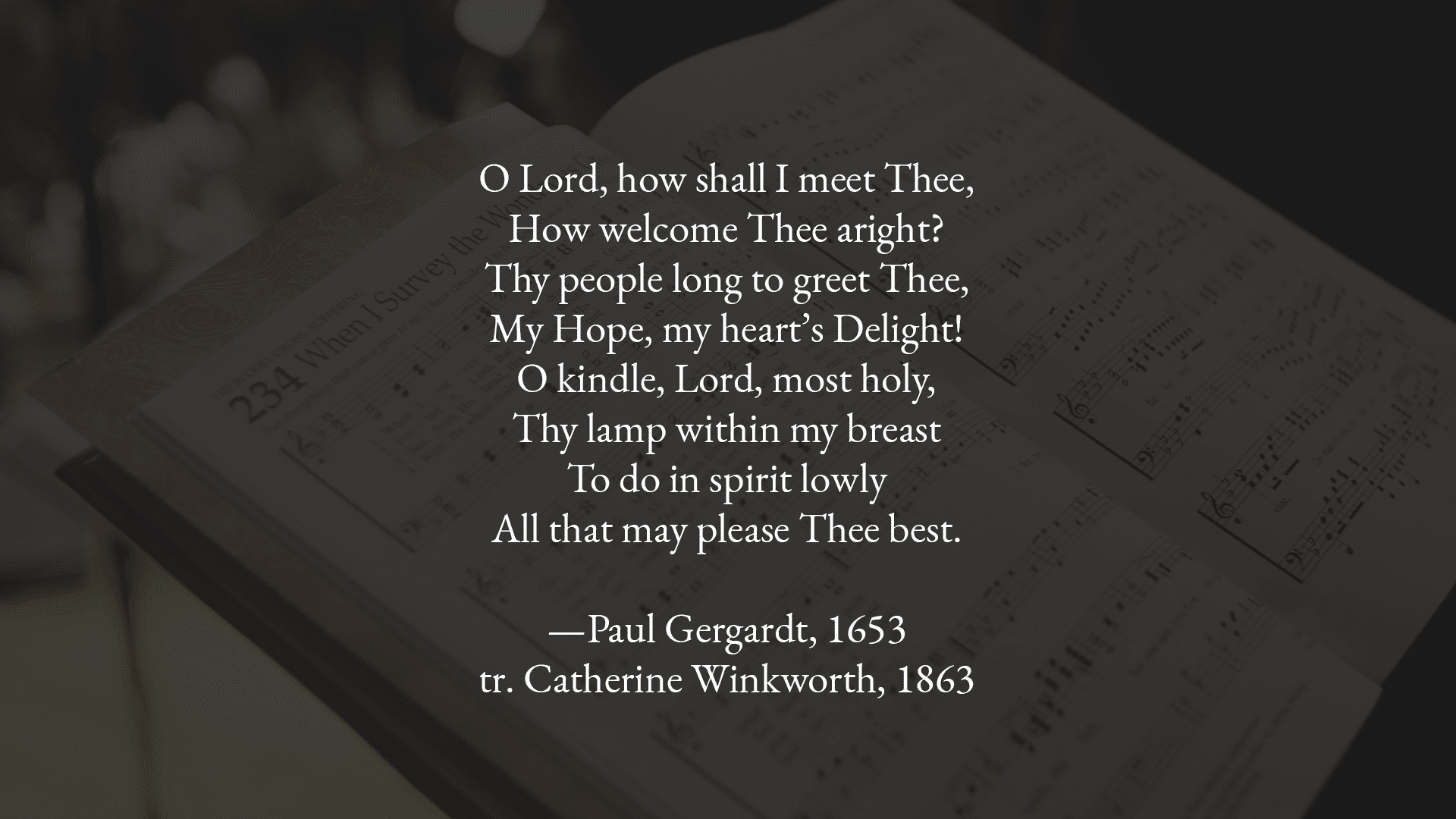I can still remember the first time I heard “O Lord, How Shall I Meet Thee.” I was on a date with my beloved wife at the St Paul Chamber Orchestra, which was playing the first cantata of Bach’s Christmas Oratorio.1The Christmas Oratorio is divided into six cantatas for the six major festivals of the Christmas season. The entire work is about three hours long. If you’re looking for a nice recording … Continue reading In the middle of the cantata, the chorale sang the first verse of this hymn to a setting of the PASSION CHORALE (we sing “O Sacred Head Now Wounded” to this tune), and I recall being struck by the unusual “major” ending of such a somber tune2Bach does something truly magnificent with the same tune in the last movement of the entire Oratorio.
It is an old German hymn written by Paul Gerhardt (1607–1676). Catherine Winkworth wrote of Paul Gerhardt, “He is without doubt the greatest of the German hymn-writers, possessing loftier poetical genius, and a richer variety of thought and feeling than any other.3(Lyra Germanica (1856), xiii. Theodore Brown Hewitt, who has contributed a significant study of Gerhardt and his influence, offers this hymn as perhaps the best advent hymn in the German language.4See here in Hewitt’s Paul Gerhardt as a Hymn Writer and His Influence on English Hymnody. The gospel reading for the first Sunday of advent was Matthew 21:1–9, and Gerhardt based his hymn on that text.
There are many English versions of this hymn (one sometimes finds it “Ah, Lord, How Shall I Meet Thee”)5Hewitt counted nine English versions of the text back in 1918. Ibid. My impression is that the most common tune setting for this hymn in English hymnals is ST THEODULPH by Melchior Teschner (the tune for “All Glory, Laud, an Honor”). The 1941 Lutheran Hymnal includes a version of the simple but pleasant tune to which the text was originally set in Gerhardt’s own day, WIE SOLL ICH DICH. Even so, I agree with J. S. Bach (a safe bet); PASSION CHORALE is a very suitable tune setting for this text as well.
The best part of this hymn are the words, of course. They are superb, as we might expect from Gerhardt. The Lutheran Hymna6St. Louis: Concordia Publish House, 1941. offers these nine (!) verses, contributed by a “composite” of translators:
1. O Lord, how shall I meet Thee,
How welcome Thee aright?
Thy people long to greet Thee,
My Hope, my heart’s Delight!
O kindle, Lord, most holy,
Thy lamp within my breast
To do in spirit lowly
All that may please Thee best.
2. Thy Zion strews before Thee
Green boughs and fairest palms,
And I, too, will adore Thee
With joyous songs and psalms.
My heart shall bloom forever
For Thee with praises new
And from Thy name shall never
Withhold the honor due.
3. I lay in fetters, groaning,
Thou com’st to set me free;
I stood, my shame bemoaning,
Thou com’st to honor me;
A glory Thou dost give me,
A treasure safe on high,
That will not fail or leave me
As earthly riches fly.
4. Love caused Thy incarnation,
Love brought Thee down to me;
Thy thirst for my salvation
Procured my liberty.
O love beyond all telling,
That led Thee to embrace,
In love all love excelling,
Our lost and fallen race!
5. Rejoice, then, ye sad-hearted,
Who sit in deepest gloom,
Who mourn o’er joys departed
And tremble at your doom.
Despair not, He is near you,
Yea, standing at the door,
Who best can help and cheer you
And bids you weep no more.
6. Ye need not toil nor languish
Nor ponder day and night
How in the midst of anguish
Ye draw Him by your might.
He comes, He comes all willing,
Moved by His love alone,
Your woes and troubles stilling;
For all to Him are known.
7. Sin’s debt, that fearful burden,
Let not your souls distress;
Your guilt the Lord will pardon
And cover by His grace.
He comes, for men procuring
The peace of sin forgiven,
For all God’s sons securing
Their heritage in heav’n.
8. What though the foes be raging,
Heed not their craft and spite;
Your Lord, the battle waging,
Will scatter all their might.
He comes, a King most glorious,
And all His earthly foes
In vain His course victorious
Endeavor to oppose.
9. He comes to judge the nations,
A terror to His foes,
A Light of consolations
And blessed Hope to those
Who love the Lord’s appearing.
O glorious Sun, now come,
Send forth Thy beams so cheering,
And guide us safely home.
I recently selected verses 1, 4, 5, and 7 when using this hymn for a communion service. It aptly reflects, not just the longing of Israel for the Messiah to come in Christ’s first advent, but our own longing for Christ to return again, to “judge the nations” and “guide us safely home.” Truly this is one of those doctrinal themes to which the Christmas season should point us. As we wait for the celebration of Christ’s birth on Christmas Day throughout the advent season, we are reminded of our eager anticipation for him to come again as “King most glorious.” Without his coming “in love all loves excelling” in his first advent, whereby we can say through the death and resurrection of Jesus “your guilt the Lord will pardon and cover by his grace,” we would have no hope of being given a “heritage in heaven” when he comes again.
I am only skimming the surface of this great hymn, and rightfully so. I would never want to provide what can come much more richly through your own meditation on this saint’s expression of his hope in Jesus Christ. But at least let me present the hymn to you, your families, and churches. We would be a richer people if we dusted off this treasure of Western Christian hymnody and set it more often before us for our edification in the most holy faith.
References
| 1 | The Christmas Oratorio is divided into six cantatas for the six major festivals of the Christmas season. The entire work is about three hours long. If you’re looking for a nice recording of it, check out Sir John Eliot Gardiner’s work (DVD / CD –at the time this article went “to press,” the DVD is cheaper than the CD!). I heartily suggest the Christmas Oratorio to those who, despite appreciating Handel’s ubiquitous opus, are looking for other superb classical sacred works fitting for the Christmas season. |
|---|---|
| 2 | Bach does something truly magnificent with the same tune in the last movement of the entire Oratorio. |
| 3 | (Lyra Germanica (1856), xiii. |
| 4 | See here in Hewitt’s Paul Gerhardt as a Hymn Writer and His Influence on English Hymnody. |
| 5 | Hewitt counted nine English versions of the text back in 1918. Ibid. |
| 6 | St. Louis: Concordia Publish House, 1941. |





